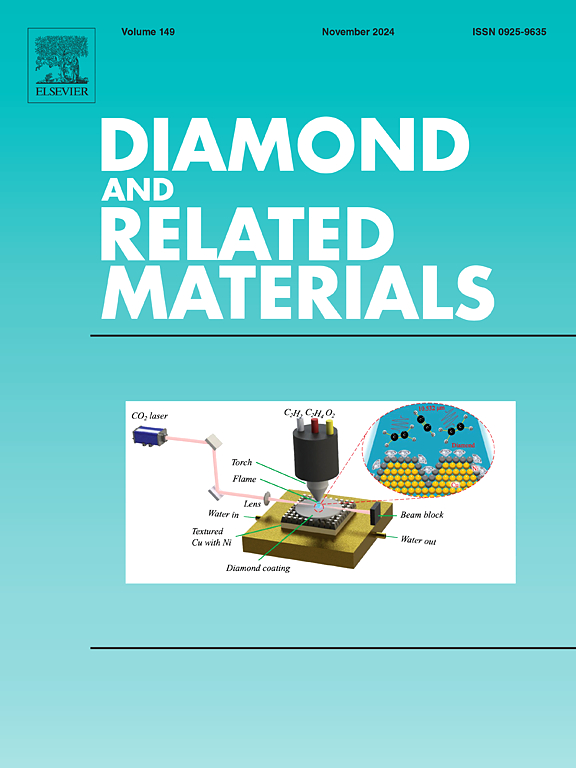g-C3N4插层ZnS纳米晶对纺织染料降解的高光敏活性
IF 5.1
3区 材料科学
Q2 MATERIALS SCIENCE, COATINGS & FILMS
引用次数: 0
摘要
以石墨氮化碳(g-C₃N₄)和Zn(NO₃)₂为原料,采用湿法化学合成工艺制备了g-C₃N₄/ZnS纳米复合材料。6H₂O克服了ZnS的带隙大、电子空穴复合快等缺点。最终材料的科学分析采用x射线衍射(XRD)、透射电子显微镜(TEM)、紫外可见光谱(UV-Vis)、傅里叶变换红外光谱(FTIR)、布鲁诺尔-埃米特-泰勒(BET)表面积分析和光致发光(PL)光谱进行结构、形态和光学表征。通过优化g-C₃N₄浓度,实现了g-C₃N₄与ZnS元素间异质结的高效构建,使g-C₃N₄具有更好的光电流响应,改善了电荷分离。3wt % g-C₃N₄/ZnS纳米复合材料的光催化性能优于所有其他样品,在90分钟的模拟阳光下获得93.0%的MO分解。卓越的效率水平超过了许多以前记录的基于zns的系统,这表明这种复合材料在有机污染物的废水处理方面具有强大的潜力。由于3wt % g-C₃N₄/ZnS纳米复合材料的优异性能,在这些废水处理系统中观察到的高效率涉及有机污染物。本文章由计算机程序翻译,如有差异,请以英文原文为准。

High photosensitization activity of g-C3N4 intercalated ZnS nanocrystal for textile dye degradation
The g-C₃N₄/ZnS nanocomposite material was developed through a wet chemical synthesis process which combined graphitic carbon nitride (g-C₃N₄) with Zn(NO₃)₂.6H₂O to overcome ZnS drawbacks including its large bandgap and fast electron-hole recombination. Scientific analysis of the final materials used X-ray diffraction (XRD), transmission electron microscopy (TEM), UV–visible spectroscopy (UV–Vis), Fourier transform infrared spectroscopy (FTIR), Brunauer–Emmett–Teller (BET) surface area analysis and photoluminescence (PL) spectroscopy for structural, morphological and optical characterization. The efficient construction of a heterojunction between g-C₃N₄ and ZnS elements was enabled by optimizing the g-C₃N₄ concentration which produced better photocurrent response and improved charge separation. Photocatalytic performance of 3 wt% g-C₃N₄/ZnS nanocomposite surpassed all other samples by obtaining 93.0 % MO decomposition using simulated sunlight in 90-minute timeframe. The exceptional efficiency level exceeds numerous previously documented ZnS-based systems which shows that this composite has strong potential for wastewater treatment of organic pollutants. The observed high efficiency in these wastewater treatment systems involves organic pollutants due to the superior performance of the 3 wt% g-C₃N₄/ZnS nanocomposite.
求助全文
通过发布文献求助,成功后即可免费获取论文全文。
去求助
来源期刊

Diamond and Related Materials
工程技术-材料科学:综合
CiteScore
6.00
自引率
14.60%
发文量
702
审稿时长
2.1 months
期刊介绍:
DRM is a leading international journal that publishes new fundamental and applied research on all forms of diamond, the integration of diamond with other advanced materials and development of technologies exploiting diamond. The synthesis, characterization and processing of single crystal diamond, polycrystalline films, nanodiamond powders and heterostructures with other advanced materials are encouraged topics for technical and review articles. In addition to diamond, the journal publishes manuscripts on the synthesis, characterization and application of other related materials including diamond-like carbons, carbon nanotubes, graphene, and boron and carbon nitrides. Articles are sought on the chemical functionalization of diamond and related materials as well as their use in electrochemistry, energy storage and conversion, chemical and biological sensing, imaging, thermal management, photonic and quantum applications, electron emission and electronic devices.
The International Conference on Diamond and Carbon Materials has evolved into the largest and most well attended forum in the field of diamond, providing a forum to showcase the latest results in the science and technology of diamond and other carbon materials such as carbon nanotubes, graphene, and diamond-like carbon. Run annually in association with Diamond and Related Materials the conference provides junior and established researchers the opportunity to exchange the latest results ranging from fundamental physical and chemical concepts to applied research focusing on the next generation carbon-based devices.
 求助内容:
求助内容: 应助结果提醒方式:
应助结果提醒方式:


